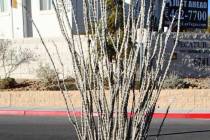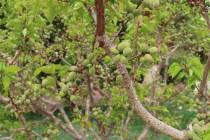Some plants grow suckers at the base of the plant and others produce suckers, or new growth, a distance away from the plant. So far, the only practical way to eliminate them is to slice the roots and remove these plants, roots and all.
Bob Morris

Bob Morris is a horticulture expert and professor emeritus of the University of Nevada, Las Vegas. Visit his blog at xtremehorticulture.blogspot.com.
Q: I have just about reached my maximum frustration level with my 35 Italian cypresses. Between spraying them down weekly in the summer to keep the mites off and them not standing on their own without staking and guy wires for 2½ years, I am ready to give up. I am thinking about replacing them with 5-gallon dwarf golden arborvitae because they are smaller and easier to spray.
Cactuses, particularly agaves, are rotting and dying from damage by the agave weevil, which that lays its eggs at the base of agave leaves. As their young hatch from the eggs, they burrow into the stem of the agave and all through it, including the roots.
One easy way to tell the difference between a bay laurel and a Carolina cherry laurel is to crush the leaves and smell the herbal aroma. Bay laurel leaves have a pungent aroma. When you crush the leaves of Carolina cherry laurel, they have an aroma of maraschino cherries rather than herbal.
A fruit tree should be solid in the soil and not wiggle after it is planted. Staking helps but doesn’t replace proper planting.
If you deploy pheromone traps in early May, the principal insect pest caught in the trap will be the peach twig borer. The peach twig borer causes wormy peach, nectarine and apricot.
Aphids are a big problem on new growth this time of year. Curling leaves is a spring indicator that aphids are present.
It is not uncommon for early apricots to set fruit first, followed shortly thereafter by leaf and shoot growth.
Standard-sized apple trees may grow to 35 or 40 feet in height. You might be able to keep a standard-sized tree under 20 feet tall through pruning, but the standard-sized apple tree is just too vigorous for pruning to short heights.
A disease called fire blight might pop up in some pear and apple trees beginning around May. It can be common several weeks after spring rains, particularly if trees were flowering. It can lead to tree death if not controlled when it’s first seen.
Delay pruning grapes as long as possible in the spring to reduce disease possibilities and avoid any late spring frost damage after pruning. Immediately after pruning grapes, consider applying a fungicide to the vines if there were problems with grape bunch diseases last year.
My experience with Mexican petunia is that it grows like a weed, and I consider it the broadleaf version of Bermuda grass, aka devil grass. If it’s contained in an area and prevented from spreading into the landscape, I think it will be OK.
An infrequent desert rain is not a problem. But when irrigation water is applied over and over to a soil that is normally dry, these soils shift, collapse and chemically change. In urban landscapes, this can be potentially destructive.
When preparing to prune plants, follow these three rules: adjusting loppers or hand shears so they don’t rip plants instead of cutting them, making sure the blade is sharp for the same reason and sanitizing the blades.
By delaying the final pruning of grapes until March 1 before new growth begins. This helps reduce disease problems from developing on the grape bunches later.






















